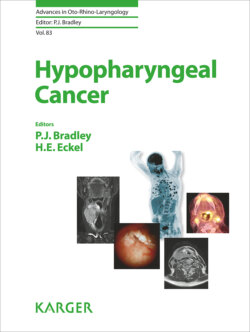Читать книгу Hypopharyngeal Cancer - Группа авторов - Страница 7
На сайте Литреса книга снята с продажи.
Preface
ОглавлениеHypopharyngeal cancer is classified as a “rare cancer or orphan disease” (<5 cases per 100,000 population) in the developed world, and recent evidence shows a stabilisation or reduction in incidence. The disease mainly affects men, but an increase in women is noted. However, in the developing world and mainly in Asia, the incidence of hypopharyngeal cancer is increasing, both in men and women, sharing aetiological factors of alcohol abuse and tobacco use, including the chewing of the betel quid or areca nut. The majority, more than 85% of patients, when diagnosed with hypopharyngeal cancer (men generally in their mid-50s) have an advanced disease stage), showing significant co-morbidities and nutritional deficiencies making treatment selection a challenge.
In the case of hypopharyngeal cancer, because of its rarity, annual small numbers and its proximity to the larynx (the majority of the published literature combines both sites), most patients receive similar treatment, resulting in outcome data survival and functional results being reported together. Towards the end of the 20th century, the aim of treatment of hypopharyngeal cancer was based on the successful results achieved (larynx preservation protocol) for advanced laryngeal cancer, preserving the organ form and its functions. Only recently, leading United States authors have admitted that extrapolation of concomitant chemoradiotherapy trial results from advanced larynx cancer to hypopharyngeal cancers may not be appropriate for management recommendations due to a lack of adequately powered. For generations of physicians and the general public, head and neck cancer has been a “Cinderella cancer,” associated with poor survival. Patients treated with hypopharyngeal cancer were likely to end up with a dysfunctional laryngo-pharynx (tracheostomy, altered voice, and nutrition through a feeding tube) for the remainder of their lives.
In recent years, the incidence of this frightening disease has steadily declining and the general condition of those affected as well as our capacity to improve results is better than before. A clear focus on avoiding unacceptable adverse effects of treatment has directed recent clinical research efforts and the prognosis is steadily improving in the developed world. While hypopharyngeal cancer is still a very serious disease, its treatment has lost some of the horrors for patients and caregivers alike.
Currently, treatment options are changing, employing various combinations, surgical and non-surgical. The selection of the most appropriate treatment for each patient with curative intent needs to be chosen with care, which results in an improvement in prognosis. Hypopharyngeal cancer has the highest rate of synchronous, second primary and metachronous cancer of all of the head and neck sub-sites. While cure of hypopharyngeal cancer can be achieved in selected patients, early death is frequent from loco-regional persistence or recurrent cancer, second primary cancer, distant metastasis and/or from co-morbidity non-malignant disease.
This volume is a compilation by recognised head and neck cancer experts, who have summarised these recent developments. The editors and authors have attempted to define the proven and currently still valid basic principles when dealing with patients presenting with hypopharyngeal cancer, while stressing new approaches and future directions. Some of the unanswered challenges relating to improving the short- and long-term outcome of patients with hypopharyngeal cancer may only be achieved by pooling data across the larger cancer institutions or by using data from national cancer registries.
The volume editors express their gratitude to each contributor for giving their time and expertise, and to Karger for their support in publishing this work.
Patrick J. Bradley, Nottingham, UK
Hans E. Eckel, Klagenfurt, Austria
